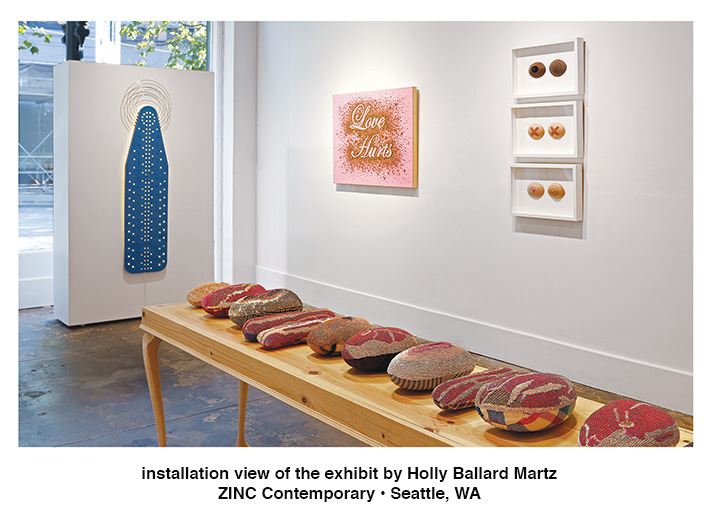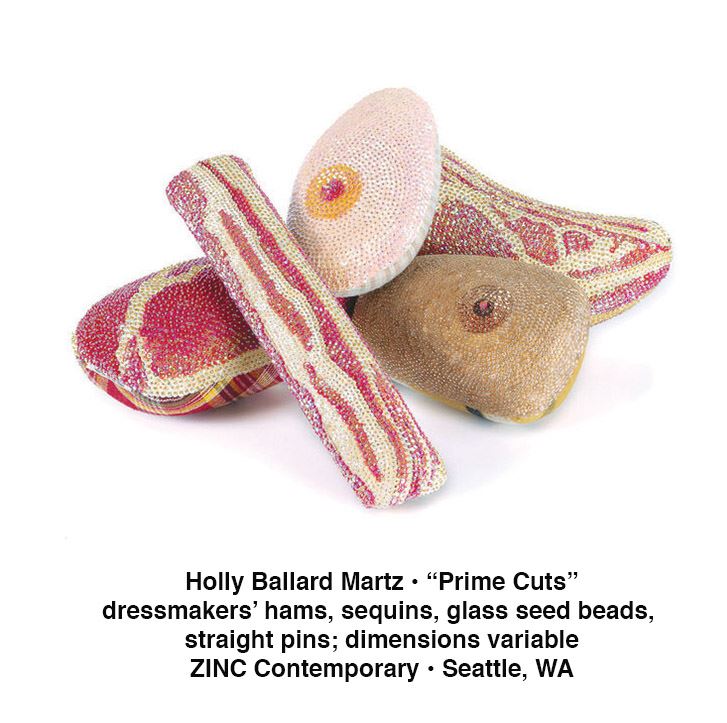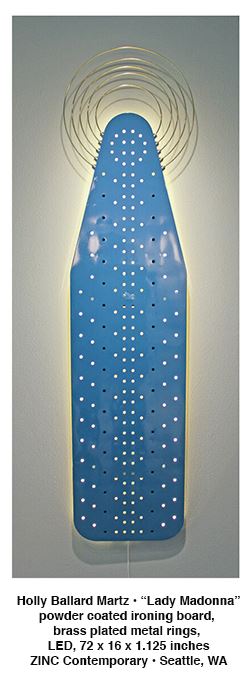
On August 20, 1920 the Nineteenth Amendment to the United States Constitution was ratified and gave women the right to vote. After a lengthy, nearly seventy year fight, the suffrage movement finally received what the women at the 1848 Seneca Falls Convention set out to accomplish. While there has been much progress towards gender equality in the past century there is still a lot of work to be done. Holly Ballard Martz’s exhibition, “Dirty Laundry & Domestic Bliss,” raises important questions about women’s rights, the patriarchy, and the role of women in society. Using mixed media artworks, Martz references or utilizes many common household objects to address these questions and provoke the viewer to think about a particular issue in a different way.
 Upon entering the gallery it is impossible not to notice the long table with sculptures that appear to be pieces of meat. The artist painstakingly applied over 40,000 sequins to the sculptures to give them a fleshy and shiny surface. As the viewer peruses the sculptures it becomes obvious that while some look like cuts of meat, others do not. There are several sculptures with obvious depictions of the vulva and vagina on the surface. Judy Chicago’s “The Dinner Party” might come to mind as an art historical reference for this imagery. Chicago’s installation evoked religious reverence for the series of tables to inform the viewer that they are about to enter a sacred space. Each plate included the name of a significant woman in world history and was set upon an intricate tablecloth.
Upon entering the gallery it is impossible not to notice the long table with sculptures that appear to be pieces of meat. The artist painstakingly applied over 40,000 sequins to the sculptures to give them a fleshy and shiny surface. As the viewer peruses the sculptures it becomes obvious that while some look like cuts of meat, others do not. There are several sculptures with obvious depictions of the vulva and vagina on the surface. Judy Chicago’s “The Dinner Party” might come to mind as an art historical reference for this imagery. Chicago’s installation evoked religious reverence for the series of tables to inform the viewer that they are about to enter a sacred space. Each plate included the name of a significant woman in world history and was set upon an intricate tablecloth.
In contrast, Martz’s installation may appear cold, even crude, with all these cuts out in the open on a bare, wooden table. The comparison is an obvious one, but Martz is careful to draw a line between them. In this case, the cuts of meat actually reference a dressmakers ham. These pillows are used as a mold for pieces of a garment that need to better fit the curves of the body, such as a waistline or sleeve. But the pillows that Martz constructed are useless as dressmakers hams because they have sequins and are really more of a decorative object. In a statement on the gallery website that artists asserts that the female body is also often reduced to cuts of meat that are laid out for decoration and the enjoyment of others. The imagery of women reduced to parts as entertainment or objects of the patriarchal gaze set up an even more somber installation directly behind the table. 
In the exhibition text Martz notes that October is Domestic Violence Awareness Month. It is impossible to ignore the bright pink wall at the end of the gallery with the cursive script, “Love Hurts”, written out with 6,000 9mm spent shell casings. The artwork is a series of contradictions. The beautiful script and color pink remind the viewer of a Valentine or sweet note between lovers. But there is obviously a much more sinister message. On the gallery website the artist cites a statistic from a survey by the National Center for Injury Prevention and Control, Division of Violence Prevention which states that almost twenty people are physically abused by their intimate partner every minute in the United States. She states a further study from the American Journal of Public Health that notes the risk of homicide increases by 500% if a gun is present during a domestic violence situation. “Love Hurts” represents the very present danger that many women and men face in their lives. Sometimes this threat is hidden from friends and family, but Martz’s bright pink wall and gold script is impossible to avoid.
 There are many other objects in the show that connect to work that historically has been done by women. There is a large blue ironing board with a series of gold halos around its “head” in reference to the artwork title: “Lady Madonna.” Martz’s well-known hangers also appear in this exhibition. They are also beautifully adorned with beaded flowers and reference the traditional work of women in the home. But these hangers aren’t useful as they are installed by the artist. Martz installed them upside down so that they are in the shape of undergarments and the female reproductive system. Every object and material in this exhibition has a purpose and supports the guiding question: Is this really domestic bliss?
There are many other objects in the show that connect to work that historically has been done by women. There is a large blue ironing board with a series of gold halos around its “head” in reference to the artwork title: “Lady Madonna.” Martz’s well-known hangers also appear in this exhibition. They are also beautifully adorned with beaded flowers and reference the traditional work of women in the home. But these hangers aren’t useful as they are installed by the artist. Martz installed them upside down so that they are in the shape of undergarments and the female reproductive system. Every object and material in this exhibition has a purpose and supports the guiding question: Is this really domestic bliss?
This exhibition and the questions it raise continue to be extremely relevant. With the election right upon us many people are discussing the points that Martz addresses through her meticulous artworks. But the issue of domestic work and duties that women often perform have also been magnified during the COVID-19 pandemic. The combination of professional work, teaching children who are now learning from home, and housework is causing many women to question their role in society. We are seeing record numbers of women leaving their professional careers as the pressures of home and family weigh down on them. It seems that the issue of dirty laundry and domestic bliss are just as relevant today as they were decades ago.
continue to be extremely relevant. With the election right upon us many people are discussing the points that Martz addresses through her meticulous artworks. But the issue of domestic work and duties that women often perform have also been magnified during the COVID-19 pandemic. The combination of professional work, teaching children who are now learning from home, and housework is causing many women to question their role in society. We are seeing record numbers of women leaving their professional careers as the pressures of home and family weigh down on them. It seems that the issue of dirty laundry and domestic bliss are just as relevant today as they were decades ago.
Chloé Dye Sherpe
Chloé Dye Sherpe is a curator and art professional based in Washington State.
“Dirty Laundry & Domestic Bliss” is on view through November 15 at ZINC Contemporary, located at 119 Prefontaine Place South in Seattle, Washington. The gallery is open Thursday through Saturday from 10 A.M. to 4 P.M. For more information, visit www.ZINCcontemporary.com.